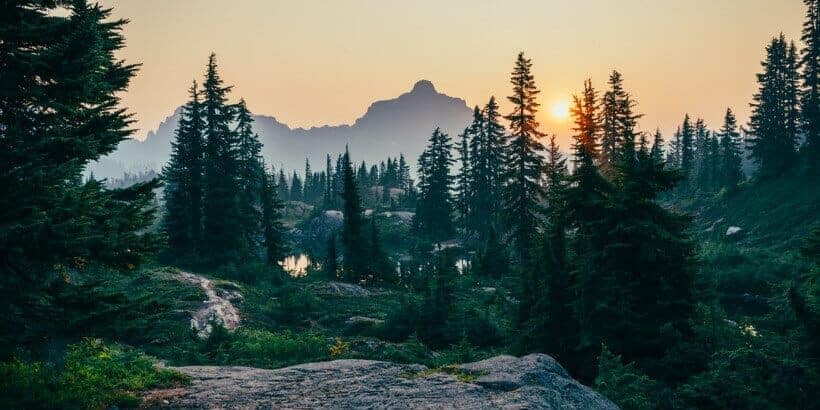Northeastern Kvass

When you’re on a fall hike, taking in the colorful leaves, sharp snaps of twigs beneath your feet, marveling at the beautifully knotted roots of the trees in front of you, you’re probably not thinking about how delicious they all taste together. But boy, you should be! Almost every ingredient in this nature-infused Northeastern Kvass can be found in a forest and with just one sip you will be transported deep into the woods whilst sipping from the comfort of home.
The following excerpt is from The Wildcrafting Brewer by Pascal Baudar. It has been adapted for the web.
This recipe is based on the forest I like to hike in Vermont. It’s a mix of pine and root flavors, a bit like a kvass root beer. It’s quite enjoyable and nutritious. The method is a bit different, as the pine branches and spruce are not boiled. Of course, maple syrup is the source of sugar for this fermentation, and the wild yeast is from a dandelion flower starter.
Ingredients
1 ⁄2–1 pound (227–454 g) rye (or other) bread
1 gallon (3.78 L) water
1–1 1 ⁄2 cups (250–360 ml) maple syrup
2 tablespoons (10 g) sassafras root bark
1 tablespoon (5 g) sarsaparilla roots (optional)
1 tablespoon (5 g) chopped dandelion roots
1 ⁄2 teaspoon (1 g) dried wintergreen leaves
Handful of turkey tail mushrooms (just because I like them and they’re good for you)
Small piece (3 ⁄4–1 inch/2 cm) gingerroot (optional)
A couple of small spruce or white pine branches, or any lemony-tasting pine needles (you can also use a couple of lemons if you want; juice them and then throw them in the pot)
1 ⁄2–3 ⁄4 cup (120–180 ml) wild yeast or commercial beer yeast
Procedure
Use a similar brewing method as Traditional Bread Kvass. The main differences are that you can place the turkey tail mushrooms in the water from the start (at the same time as the sugar) so they boil longer than the other ingredients. The spruce or white pine branches are added when the liquid is cooled down and the yeast goes in. It’s a personal choice, but I don’t like the flavor of boiled spruce/fir/pine. Don’t forget to cut the top of the needles so the flavors can be extracted. Because I use lots of barks, dried leaves, and roots in this recipe, I don’t place the pot in cold water but simply set it outside. The warm water cools slowly, and I extract more flavors that way.
- Slice the bread and break the slices into smaller pieces. Place them in a preheated 350°F (177°C) oven for 10 minutes, then broil on high until golden brown—this can take 3 to 5 minutes depending on your oven. You basically want your bread to look like slightly overdone toast, which will give the brew a nice amber look and better flavors.
- Meanwhile, pour the water and sugar into a pot and bring the liquid to a boil. Place the toasted bread, herbs, and raisins in the boiling liquid and stir briefly. Bring the liquid back to a boil, then remove the pot from the heat.
- Place the pot (with the lid on) in cold water and cool the liquid to 70°F (21°C), then add the yeast (1 ⁄2 to 3 ⁄4 cup or 120–180 ml for wild yeast starter). Either keep everything in the original pot with the lid on or transfer the contents into a fermenting bucket fitted with an airlock or a clay pot/glass container with a clean towel on top.
- Ferment for 8 to 12 hours, until you see some bubbling going on, then strain the liquid into a bottle or into recycled soda bottles if you want carbonation. Check the pressure and place the bottles in the refrigerator when ready. Drink within a couple of weeks.
Recommended Reads
Recent Articles
The Garlic Clove! This small crop adds a big punch of flavor that complements almost every delicious dish you could think of. And the best part? These two recipes are a breeze to make together!
Read MoreOur love affair with amaranth began long before the pseudo-grain became a trendy staple for gluten-free folk. The luscious leaves of this annual plant are not only packed with a plethora of health benefits.
Read MoreDon’t know where to start for foraging wild plants? Read on for the information you need to begin foraging on your own: where to do it and how to be safe.
Read MoreEasy rainbow coleslaw! Transform your salad game with this colorful recipe. It is surprisingly packed with flavor and is a great addition to your repertoire.
Read MoreIf you love tomatoes, you probably already know just how many varieties of these summertime staples there are. But do you know what makes each one unique?
Read More









